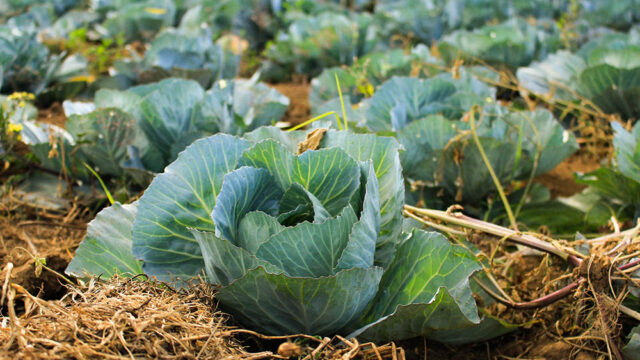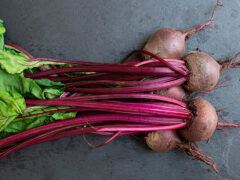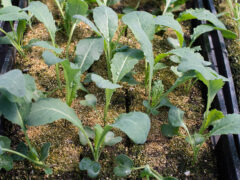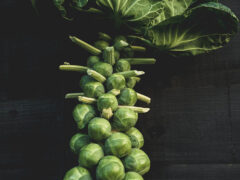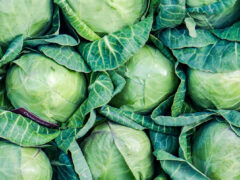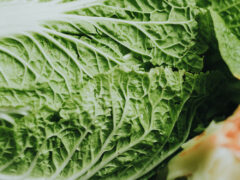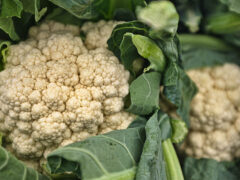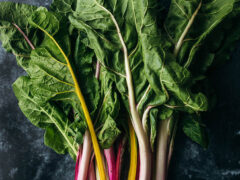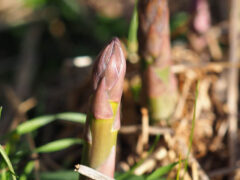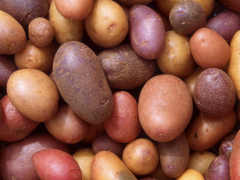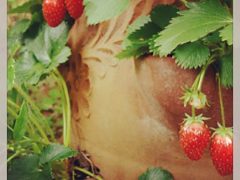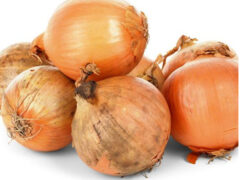“Cole crop” is the general term used to describe broccoli, Brussels sprouts, cabbage, cauliflower, collards, kale, and kohlrabi. As a group, these plants grow better in cool weather which leads many people to think that the word “cole” is a variation of the word “cold” and they may even refer to these plants as cold crops. The word “cole” actually originated from the Latin word caulis meaning stem or stalk of a plant.
Cole crops can be planted at the same time as seed potatoes, onion sets, and asparagus crowns. It’s also time to direct sow lettuce and spinach seed.
Need to make soil improvements? We have bulk compost available for pick up or delivery!
COLE CROPS
Beet
Beta vulgaris
'Early Wonder' is a popular heirloom beet variety that produces high yields of deep red roots. Tasty, early maturing, and produces abundant greens.
Gourmet Blend: 'Detroit Dark Red' has deep red roots and delicious dark green tops and 'Golden' has bright yellow flesh.
'Bulls Blood' is a sweet and tender beet, grown as much for its roots as it is for its foliage. Plant Bull's Blood beets in full sun and get ready to harvest in just 55 days. A very tasty and versatile beet, it's delicious baked, pickled, or boiled. Beets are great for boiling, pickling, baking, and freezing. Forms 3-4" deep red globes that are sweet and tender. Also known as "Tall Top" for its tall, glossy leaves that make great greens with salads. Greens are also a great substitute for chard or spinach and have high vitamin A and C.broccoli
Brassica oleracea var. italica
Bright green rounded heads form on medium-sized plants for mid-summer harvest when transplanted in March and April. Heat-resistant plants are slow to bolt and plants prefer sull sun. Plants 24 to 30 inches apart in rows 12 to 14 inches apart. Mulch to control weeds and to keep the soil cool.
'Purple Magic' heads are a beautiful deep purple overlaid on a dark green background with vibrant, bright violet stems. Darker purple and more attractive than other purple varieties. 2024 AAS Winner.
'Waltham 29' heirloom broccoli has been cultivated for higher yields, uniformity, and repeat harvests. Acclimated to New England chill, non-GMO Waltham 29 seeds grow compact and cold-hardy. An open-pollinated American staple for home gardens and market growers. Watch for cabbage worms and aphids. Cabbage worms can be picked off. Aphids can be blasted off with a water hose or sprayed with insecticidal soap if .‘Long Island Improved’ Brussels Sprouts
Brassica oleracea var gemmifera
Each stalk can bear 50-100 dark-green sprouts over an extended period. Compact plants produce sturdy spikes with edible florets that mature from the bottom up and take on sweeter flavor after a light frost. Toward the end of the growing season, cut off the top 4-6 inches of the plant to force the energy into the existing sprouts; the remaining sprouts should mature in 3-6 weeks. Introduced in the 1890s, this historic variety was once the most important commercial sprout in the United States.
Cabbage
Brassica oleracea var. capitata
'Early Flat Dutch' has excellent heat tolerance and produces large, flat heads, weighing 6-10 lbs. The flat heads are easier to cut than round heads—plenty of cabbage for processing into slaws and sauerkraut. Stores well. Grown in spring and fall gardens.
'Red Acre' produces medium-sized, attractive maroon heads. A sweet and delicate flavor.
‘Yuki’ Chinese Cabbage
Brassica rapa var pekinensis
Good uniformity and large head size with tolerance to Black Speck and tipburn. 'Yuki' is bred for spring to early summer harvest in areas where bolting is a problem. Young heads can be harvested for a tender and delicious salad addition.
cauliflower
Brassica oleracea var. botrytis
Plant spring cauliflower 2 to 4 weeks before the last frost in the ground or large container. Plant cauliflower in rows with each plant spaced 18 inches apart. Rows should be 30 inches apart. Improve garden soil by adding compost and other rich organic matter. Mulch and give plants 1 to 1.5 inches of water weekly. Cover young plants to protect them from cold weather. When the cauliflower head is about the size of a golf ball, gently fold leaves over the head and secure them in place with twine. Harvest cauliflower heads when they are still compact but large enough to eat, about 6 to 8 inches in diameter. Rotating crops each year will prevent any soil-borne diseases specific to cauliflower from taking hold. Choose 'Di Jesi', 'Graffiti Purple,' 'Vitaverde,' and 'Snow Crown'
SUMMER CROPS THAT CAN HANDLE THE COLD!
‘Bright Lights’ Swiss Chard
Beta vulgaris
This stunning chard seed mix is as ornamental as it is delicious, with stems in gold, pink and crimson. A few plants will be white and pink striped, orange, scarlet, purple, green and white. All are delicious to eat, though they are at their best harvested young for salads. Pick from late spring until winter. Grows best in full sun but will tolerate light shade. Swiss chard is very cold tolerant and will continue to grow in the garden through frosts until temperatures drop to the mid-20's. Swiss chard is very heat tolerant and will produce greens through the summer. Foliage will regrow another crop about 7-10 days after cutting so you can continue harvesting all summer.
Redbor Kale
Brassica oleracea (Acephala Group) 'Redbor'
This curly kale has gorgeous red and purple color. Continuously cut for yields all season. Frilly, curled leaves have deep purple stems and veins running throughout. Some plants are entirely magenta, though at times, others may have leaves that are tinged with green. Growing between 18 to 24 inches in height, Redbor kale offers a mild cabbage-like flavor and crisp texture. When cooked it becomes tender and nutty with a mild earthy sweetness. An excellent source of vitamins A and C, iron, calcium, magnesium, potassium, protein, carbohydrates and dietary fiber.
SETS, CROWNS & PIPS
Asparagus
Asparagus officinalis
'Mary Washington' produces uniform spears and a heavy yield. This perennial vegetable is disease-resistant to rust, it is extremely cold-hardy and heat-tolerant, making it a low-maintenance addition to your garden!
'Purple Passion' produces purple spears with a mild, nutty flavor and are reputedly sweeter than most other asparagus varieties. Purple color is especially nice for salads. Spears turn green when cooked.
'Jersey Knight' is extremely vigorous and produces large, succulent spears. Excellent flavor. Plants are resistant to rust, crown rot, and fusarium. It performs equally well in heavy, clay-like soils.
seed potatoes
Solanum tuberosum
Potatoes are one of the easiest root crops to grow! They grow in average soil and a small area can provide a nice yield of this tasty vegetable.
Due to its compact size, 'Red Norland' is ideal for small gardens. It is an outstanding red potato with shallow eyes and excellent flavor. It was developed for northern growers but is widely adaptable.
'Kennebec' is a large potato with thin, light tan skin that allows for quick and easy peeling. It has a uniform appearance and white fleshy insides. It has resistance to blight and other diseases.
'Russet Norkotah' is a long, smooth, shallow-eyed potato. It is adaptable in many areas and generally has a 7 to 9-month storage life. Its versatility and flavor make this potato ideal for baking.
'Pontiac Red' is a great mashing potato thin red skins, shallow eyes and crisp white flesh. They also make beautiful new potatoes. An excellent choice for planting in heavy soils. Potatoes store well.
Plant in early spring in a sunny location. Water weekly through warm summer weather but do not overwater.
Click here for full instructions!
strawberry
Fragaria ananassa
Glossy red, long-necked fruit, ‘Ozark Beauty’, 'Tri Star', 'Seascape' and ‘Eversweet’ have a mild, sweet flavor. Very productive everbearing varieties will bear fruit in late spring and again in fall. 'Chandler', 'Honeoye', ‘Surecrop’ and ‘Earli-Glow’ are popular June-bearing varieties, producing good crops in almost any growing region or soil type. Firm fruit is useful for fresh eating or the freezer. Plant June-bearing and everbearing for continuous fruit production.
